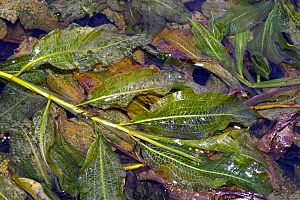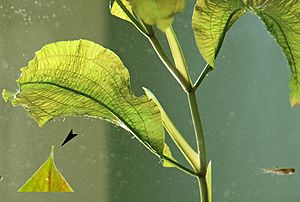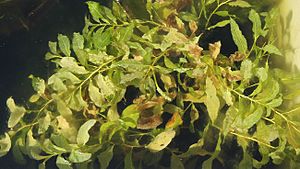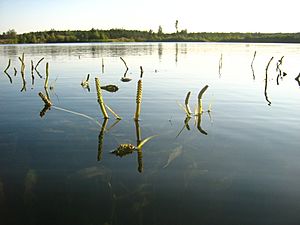Shining pondweed facts for kids
Quick facts for kids Shining pondweed |
|
|---|---|
 |
|
| Scientific classification | |
| Genus: |
Potamogeton
|
| Species: |
lucens
|
| Synonyms | |
|
|
Potamogeton lucens, also known as shining pondweed, is a water plant. It is a perennial which means it lives for more than two years. You can find it in Europe, Asia, and North Africa. This plant grows in deep, calm, or slow-moving freshwater. It prefers water that has a lot of calcium (like hard water).
Contents
What Does Shining Pondweed Look Like?
Shining pondweed is a big plant. It has strong rhizomes (underground stems) that creep along the bottom. Its stems are long, round (called terete), and branch out. They usually grow up to 2.5 meters (about 8 feet) long. Some can even reach 6 meters (about 20 feet)!
Leaves and Flowers
The leaves are large, usually 7.5 to 20 centimeters (3 to 8 inches) long. They are 2.5 to 6.5 centimeters (1 to 2.5 inches) wide. The leaves are light green or yellowish and look shiny. You can see a clear net-like pattern of veins on them. Their edges have tiny teeth (called denticulate). Each leaf has a short stem (called a petiole) that connects it to the main stem. This plant does not have leaves that float on the water's surface.
Flowers appear from June to September. The fruits are small, about 3 millimeters (0.1 inches) across.
Similar Plants and Hybrids
In most places, shining pondweed is easy to recognize. But in southern Europe, there is a similar plant called P. schweinfurthii. Shining pondweed usually has wider leaves. Most or all of its leaves have petioles.
Shining pondweed can also mix with other pondweed species. When two different species mix, they create a hybrid. Some common hybrids include those with P. gramineus and P. perfoliatus. These hybrids can sometimes be hard to tell apart from shining pondweed.
How Scientists Classify Shining Pondweed
The name Potamogeton lucens means 'shining pondweed'. The word lucens means 'shining' in Latin. Carl Linnaeus, a famous scientist, first named this plant in 1753. Shining pondweed can look different depending on where it grows. Because of this, it has had many different scientific names over time.
Scientists use DNA to study plants. DNA tests show that shining pondweed belongs to a group of broad-leaved pondweeds. It is closely related to P. gramineus and a North American plant called P. illinoensis.
Where Does Shining Pondweed Live?
Shining pondweed is found in many parts of the world. It grows across Europe, including Britain and Scandinavia. You can also find it in parts of Asia, like India and Russia. It lives in the Middle East and North Africa too. In North America, a similar plant, P. illinoensis, takes its place.
Special Abilities of Shining Pondweed
Scientists have found interesting things about shining pondweed. A special substance from the plant can stop algae from growing. This means it can help keep water clean.
Dried shining pondweed can also soak up heavy metals from water. This suggests that this plant could be used to clean up polluted water areas.
Where Shining Pondweed Grows and Its Importance
Shining pondweed is a lowland plant. It likes calm or slow-moving water that has a lot of calcium. It especially likes areas with peat where the water supply is rich in calcium. It prefers deep water, usually 0.5 to 2 meters (1.5 to 6.5 feet) deep. It can also grow in shallower areas or in open reedbeds.
This plant is more common in older lakes that are not well connected to rivers. It does not spread easily and takes a long time to grow back after floods. It also does not like it when water levels drop too much.
In Britain, shining pondweed is mostly found in southern England. It is more common in Ireland. It can handle some eutrophication (when water gets too many nutrients). If there are too many nutrients, it might replace other plants like Chara species. But if nutrient levels get even higher, tiny phytoplankton can take over.
Shining pondweed is not considered in danger globally. It has decreased a bit in Britain but is still quite common. It is part of a group of pondweeds called Magnopotamion. These plants are important for a protected habitat type called 'Natural eutrophic lakes with Magnopotamion'.
How to Grow Shining Pondweed
Shining pondweed is not often grown by people, even though it is easy to grow and looks nice. Its large, clear, netted leaves are unique. Like other pondweeds, it does not grow well from stem cuttings. The best way to grow it is by dividing its rhizomes (underground stems).
You can easily grow it in a garden pond or even a large barrel. But unlike some other water plants, it needs to root in soil. You can use sand or special aquatic compost. When you first plant it, you should weigh it down so it can root properly. If there are waterfowl (like ducks) nearby, you might need to protect the plants, especially when they are young in early summer.
See also
 In Spanish: Potamogeton lucens para niños
In Spanish: Potamogeton lucens para niños




